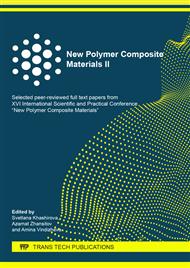[1]
G.V. Kozlov, Yu.G. Yanovskii, G.E. Zaikov, Particulate-Filled Polymer Nanocomposites. Structure, Properties, Perspectives. Nova Science Publishers, Inc., New York, (2014).
Google Scholar
[2]
G.V. Kozlov, A.K. Mikitaev, Structure and Properties of Nanocomposites Polymer/Organoclay. LAP LAMBERT Academic Publishing GmbH and Comp., Saarbrücken, (2013).
Google Scholar
[3]
M. Moniruzzaman, K.I. Winey, Polymer nanocomposites containing carbon nanotubes, Macromolecules. 39 (2002) 5194-5205.
DOI: 10.1021/ma060733p
Google Scholar
[4]
H. Kim, A.A. Abdala, C.W. Macosko, Graphene/polymer nanocomposites, Macromolecules. 45 (2010) 6515-6530.
DOI: 10.1021/ma100572e
Google Scholar
[5]
R. Jan, P. May, A.P. Bell, A. Habib, U. Khan, J.N. Coleman, Enhancing the mechanical properties of BN nanosheet-polymer composites by uniaxial drawing, Nanoscale. 6 (2014) 4889-4895.
DOI: 10.1039/c3nr06711d
Google Scholar
[6]
U. Khan, P. May, A. O'Neill, A.P. Bell, E. Boussac, A. Martin, J. Semple, J.N. Coleman, Polymer reinforcement using liquid-exfoliated boron nitride nanosheets, Nanoscale. 5 (2013) 581-587.
DOI: 10.1039/c2nr33049k
Google Scholar
[7]
G.V. Kozlov, I.V. Dolbin, Structural aspects of strengthening nanostructured polymer/2D-nanofiller composites, Materials Physics and Mechanics. 32 (2017) 94-101.
Google Scholar
[8]
G.V. Kozlov, I.V. Dolbin, S.A. Kuvshinova, O.I. Koifman, Comparative analysis of the reinforcement of polymers with 2D-nanofillers: organoclay and boron nitride, Doklady Physics. 63 (2018) 113-116.
DOI: 10.1134/s1028335818030060
Google Scholar
[9]
G.V. Kozlov, I.V. Dolbin, The role of nanoparticle network in 2D nanofiller-reinforced polymer nanocomposites, Russian Physics Journal. 61 (2018) 974-978.
DOI: 10.1007/s11182-018-1485-4
Google Scholar
[10]
G.V. Kozlov, I.V. Dolbin, The mechanisms of growth and the structure of 2D-nanofiller clusters in polymer media, Physics of the Solid State. 61 (2019) 39-43.
DOI: 10.1134/s1063783419010141
Google Scholar
[11]
G.V. Kozlov, I.V. Dolbin, Reinforcement of polymer/2D-filler nanocomposites: basic postulates, Physics of the Solid State. 61 (2019) 1433-1436.
DOI: 10.1134/s1063783419080158
Google Scholar
[12]
G.V. Kozlov, I.V. Dolbin, Dependence of the degree of reinforcement of polymer/2D-nanofiller nanocomposites on the nanofiller surface structure, Journal of Surface Investigation: X-ray, Synchrotron and Neutron Techniques. 13 (2019) 1086-1089.
DOI: 10.1134/s1027451019060119
Google Scholar
[13]
A.K. Mikitaev, G.V. Kozkov, G.E. Zaikov, Polymer Nanocomposites: Variety of Structural Forms and Applications, Nova Science Publishers, Inc., New York, (2008).
Google Scholar
[14]
A.K. Mikitaev, G.V. Kozkov, Description of the degree of reinforcement of polymer/carbon nanotube nanocomposites in the framework of percolation models, Physics of the Solid State. 57 (2015) 974-977.
DOI: 10.1134/s1063783415050224
Google Scholar
[15]
I.M. Sokolov, Dimensions and others geometrical critical indices in percolation theory, Physics – Uspekhi. 151 (1986) 221-248.
Google Scholar
[16]
J.N. Coleman, M. Cadek, K.P. Ryan, A. Fonseca, J.B. Nady, W.J. Blau, M.S. Ferreira, Reinforcement of polymers with carbon nanotubes. The role of an ordered polymer interfacial region. Experimental and modeling, Polymer. 47 (2006) 8556-8561.
DOI: 10.1016/j.polymer.2006.10.014
Google Scholar
[17]
P.A. Andrievsky, Nanomaterials: conception and modern problems, Russian Chemical J. 46 (2002) 50-56.
Google Scholar
[18]
G.V. Kozlov, G.E. Zaikov, Structure of the Polymer Amorphous State, Brill Academic Publishers, Utrecht-Boston, (2004).
Google Scholar
[19]
A.K. Mikitaev, G.V. Kozlov, The dependence of reinforcement degree of nanocomposites polymethylmethacrylate/functionalized carbon nanotubes on nanofiller structure, Fizika i Khimiya Obrabotki Materialov. 4 (2015) 65-69.
Google Scholar
[20]
D.W. Schaefer, R.S. Justice, How nano are nanocomposites? Macromolecules. 40 (2007) 8501-8517.
DOI: 10.1021/ma070356w
Google Scholar
[21]
A.K. Mikitaev, Yu.N. Karnet, G.V. Kozlov, Definition of the term nanocomposite, on the example of nanostructured polymer/organoclay composites, Nanomechanics Science and Technology. An International J. 7 (2016) 27-38.
DOI: 10.1615/nanomechanicsscitechnolintj.v7.i1.20
Google Scholar


